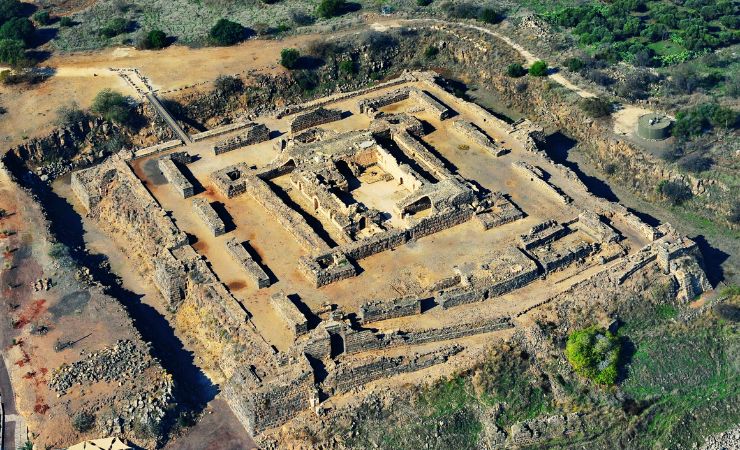Kochav HaYarden (Belvoir Fortress): A Crusader Jewel Overlooking the Jordan Valley
Kochav HaYarden (Hebrew for ‘Star of the Jordan) Or Kawkab al-Hawa (Arabic for ‘Star of the Wind’ or ‘Star of the Winds’) is a Crusader fortress, Belvoir, that offers breathtaking views and a fascinating glimpse into medieval military architecture and conflict.

Location
Kochav HaYarden is strategically positioned on a hill at the eastern edge of the Issachar Plateau in northern Israel, on the edge of Lower Galilee. Standing 500 meters (1,600 ft) or 550 meters (1,800 ft) above the Jordan River Valley level, the fortress commanded a vital route from Gilead into the Kingdom of Jerusalem via a nearby river crossing.
A Strategic Stronghold in the Jordan Valley
The story of Belvoir starts in 1168, when the Knights Hospitaller—a Catholic military order known for caring for the sick and defending Christian territories in the Holy Land—purchased the site from a French nobleman named Velos. The land cost them 1,400 gold bezants, which would be worth about $200,000 today. Recognizing its value, the order quickly began building a fortress on this strategic hilltop overlooking the Jordan Valley.
Under the leadership of Grand Master Gilbert of Assailly, construction began immediately. The stronghold was built as a defensive barrier to stop Muslim forces from advancing into the Crusader-controlled Kingdom of Jerusalem from the east.
A Fortress Built for Battle
Kochav HaYarden (Belvoir) is a standout example of a “concentric castle”—a design that uses two sets of defensive walls, one inside the other. This approach made the fortress more resistant to siege attacks and became a model for later castles in Europe and the Middle East.
Archaeological excavations in the 1960s revealed just how advanced the layout really was. The design is simple but highly effective:
Outer Wall: A square fortress measuring 110 by 110 meters, with square towers at the corners and midpoints of each side.
Inner Fortress (Keep): Another square structure inside the outer wall, roughly 50 by 50 meters. This had four corner towers and an extra tower on the west side. It stood slightly taller than the outer wall.
Courtyard: A rectangular space between the two walls allowed for movement and defense.
Defensive Features
A dry moat 20 meters wide and up to 14 meters deep was carved into the bedrock around three sides of the fortress. The stone dug out was reused in construction.
The eastern side was protected by a steep cliff and an external tower (barbican), making a direct assault nearly impossible.
Sloped tower bases prevented attackers from digging tunnels underneath.
Loopholes (narrow slits in the walls) allowed defenders to shoot arrows while staying protected.
The tower layout enabled defenders to fire on attackers from multiple angles, covering each other’s blind spots.
Hidden exits with narrow staircases—allowed knights to launch surprise attacks or send messengers out during a siege.
The main entrance was placed in a hard-to-reach corner and involved climbing a ramp and turning sharply to enter, making it difficult for enemies to storm the gate.
A secondary entrance on the west side included a drawbridge over the moat.



The Great Siege and the Fall of Belvoir
The first serious test came in 1180, when Saladin’s forces launched an assault that the fortress managed to repel. Two years later, in 1182, a major battle took place near the castle between Saladin and King Baldwin IV of Jerusalem.
Things changed dramatically after the famous Battle of Hattin in July 1187, when Saladin crushed the Crusader army and began reclaiming much of the Kingdom of Jerusalem. With the Crusaders in retreat, Belvoir stood as one of only three major fortresses still resisting.
Muslim forces reached Belvoir in July 1187. They weren’t able to break through the defenses, so they began a siege. The Hospitallers made surprise raids, and in December they wiped out an entire unit of Saladin’s army. Even when supplies began to run low, they managed to restock by ambushing convoys carrying loot from other captured Crusader towns.
Saladin himself arrived in March 1188, determined to take the castle. But even with his leadership, the siege didn’t succeed. His army lifted the siege temporarily in May 1188.
By the end of that year, Saladin’s troops returned, and this time they were more determined than ever. Winter conditions made the fighting even harder, and losses on both sides were heavy. Eventually, Muslim engineers (called sappers) managed to tunnel under part of the eastern wall and collapse a tower, creating an entry point. Even then, the Crusaders kept fighting inside the fortress.
Realizing they couldn’t hold out forever, the Hospitallers negotiated terms. Saladin, impressed by their resilience and bravery, allowed them to leave peacefully with their belongings and head north to Tyre. The official surrender took place on January 5, 1189, after an exhausting siege that had lasted for 18 months.
Kochav HaYarden (Belvoir) Today: A Well-Preserved Crusader Legacy
Kochav HaYarden (Belvoir) is the best-preserved Crusader fortress in Israel—and visiting it today offers a rare chance to walk through a medieval stronghold that still shows its original structure. After careful excavation and partial restoration, the site is open to the public and makes for a rewarding visit, especially for those interested in history or architecture.
In the outer courtyard, vaulted halls once served as stables, storage spaces, and living quarters for the garrison stationed here. Moving inward, you’ll reach the inner fortress—the keep—which was designed as the final stronghold if attackers managed to breach the outer defenses. At the heart of the keep is a central courtyard, where you can still see the remains of a cistern and a laundry area, both essential for daily survival. Nearby, the kitchen remains surprisingly intact, with three built-in stone stoves still visible. One especially personal detail is a carved game board for “Nine-Men’s Morris,” a strategic game popular among the knights—offering a quiet, human glimpse into their off-duty lives. You can even descend into the moat via staircases to get a sense of the sheer height and scale of the walls towering above.
Nearby Sites
Beit She’an National Park – Just a 20-minute drive away, this impressive site features well-preserved Roman and Byzantine ruins, including a theater, bathhouses, and colonnaded streets.
- Mount Gilboa – A scenic ridge with hiking trails and stunning views over the Jezreel and Jordan Valleys. In spring, it’s covered in wildflowers, including the famous Gilboa Iris.
- Tiberias and the Sea of Galilee – Less than an hour north, you can visit this historic lakeside town known for ancient synagogues, boat rides, and traditional fish meals along the shore.
- The Ancient Synagogue of Beit Alfa – Famous for its beautifully preserved 6th-century mosaic floor, including a zodiac wheel—an intriguing mix of Jewish and Greco-Roman symbolism.
- Ein Harod (Ma’ayan Harod) National Park – A peaceful park built around a spring at the foot of Mount Gilboa, associated with the biblical story of Gideon (Judges 7). Great for picnicking and light hikes.

